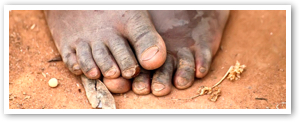The Rise of the Victim Bully
- FATHER DWIGHT LONGENECKER
One of Christianity's contributions to civilization has been a startling compassion for the victim.
 As René Girard has pointed out, from the beginning of time primitive peoples focused their animus on the outsider, the oddball, or the eccentric in their midst. It was the disabled, the alien, the poor, and the weak who most often took the blame for society's ills. The crowd turned on them as the origin and cause of their problems. They became the scapegoat. As they were ostracized, excluded, persecuted, and killed, the source of the tribe's problems was eliminated.
As René Girard has pointed out, from the beginning of time primitive peoples focused their animus on the outsider, the oddball, or the eccentric in their midst. It was the disabled, the alien, the poor, and the weak who most often took the blame for society's ills. The crowd turned on them as the origin and cause of their problems. They became the scapegoat. As they were ostracized, excluded, persecuted, and killed, the source of the tribe's problems was eliminated.
Consequently, the tribe felt cleansed. The violence unleashed a feeling of power and freedom. As the evil was purged, thrill surged. All was well. Life could continue and the tribe could prosper. Until, of course, another crisis developed — and at that point another victim would be needed. Because of the regularity of the crises, religions developed the ritual of regular sacrifice. Victims were found, throats were cut, blood was shed, and if animals were substituted, it did not mitigate the truth that the society still ran on the blood-fuel of the victim.
This may seem terribly primitive in a modern age, until one see videos of ISIS soldiers ritually beheading their victims. Modern Americans may think they are far removed from the barbarities of the Aztecs until they view a video of a wine-sipping high priestess of the cult of abortion describing how she dismembers children and harvests their organs. Is this so far removed from the haruspication of the ancients? When crazed and enraged young men — be they Islamist or racist extremists — open fire on their innocent victims, are we so far from Girard's theory of the scapegoat?
Girard points out that Jesus of Nazareth turned the model on its head. He does so first by valuing the victim. The poor, the outcast, the crippled, diseased, blind, and demon-possessed are his prizes. He treasures children and magnifies women. He turns the sacrificial system upside down not only by valuing the victim, but by becoming the victim. He accepts the victim role and willingly becomes "the Lamb of God" who takes away sin of the world. He defeats the sacrificial system by embracing it. He breaks it from the inside. For the last two thousand years, the world has been learning that the victim is the hero.
For the last two thousand years, the world has been learning that the victim is the hero.
The problem is that everyone is jumping on the bandwagon. Being a victim is fashionable — ironically, becoming bullied is now the best way to bully others. It works like this: If you want to move forward in the world, make progress for you and your tribe, further your ambitions, justify your immoral actions, grab a bigger piece of the pie, and elbow others away from the trough, simply present yourself and your tribe as victims. Once you successfully portray yourselves as a poor, outcast, persecuted, minority group you instantly gain the sympathy of all.
The first key to success in this campaign is to portray your victim condition as something over which you have no control. This is clear when the victim group is a racial or ethnic minority. The same sense of unjust destiny has to be produced for other groups. So the feminists have exploited the technique to portray all women as downtrodden. Homosexual campaigners have likewise insisted that their condition is something they were born with, and now anyone with a sexual proclivity that is other than heterosexual can be portrayed as a misunderstood and persecuted victim.
People suffering from any kind of illness, disability, or misfortune are victims of some sort of injustice, cruelty, or neglect. Those who suffer from poverty, addiction, broken families, psychological problems, emotional distress, or just plain unhappiness are victims too. The victim mentality is linked with an entitlement culture: Someone must be culpable for the unhappiness of the victims because someone should be responsible for making them happy.
The second step in effective victim-campaigning is to accumulate and disseminate the propaganda. Academic papers must be written. Sociological studies must be undertaken. Groundbreaking books must be published. Stories of the particular minority group being persecuted must make front page news. The whimpers of the persecuted must rise to heaven. The shock at their victimhood must be expressed as "sadness," "concern," and "regret." If one is not sympathetic, if one is reticent to pour balm in the victim's wounds, then the bullying begins. You must recognize the victim. You must be sympathetic. You must be tolerant. You must join the campaign to help the victim, solve their problems, and make them happy at last. If you do not, you are not only hard-hearted, you are part of the problem.
The third stage of the campaign is the release of anger. Once the victim is identified and the information is widespread, the rage can be released. The anger must be expressed because, without knowing it, a new cycle of tribal scapegoating has developed. As the tribe gathers around the victim in sympathy, they must find the culprit, and their search for the culprit (whether he is guilty or not does not matter) sends them on the same frantic scapegoating quest that created their victim in the first place. The supposed persecutors have now become the persecuted. The unhappiness of the tribe (which presents itself as sympathy for the victim) is now focused on violence against the new victim — and so the cycle of sin and irrational rage continues.
Observe American society today. Everywhere you look we are apportioning blame and seeking scapegoats. The blacks blame the whites. The whites blame the blacks. The homosexuals blame the Christians. The Christians blame the homosexuals. The Republicans blame the immigrants. The immigrants blame the residents. The workers blame the wealthy. The wealthy blame the workers.
If a society has a religion of sacrifice the ritual victim becomes the focus of the tribal animus.
Why has our society descended into the violence of scapegoating and blame? Because it is inevitable. The victimhood cycle will continue through cycles of revenge and further victimhood unless there is an outlet.
Where is there an end to the cycle of violence and victimization? There is only one solution: Find a constant victim — one who is the eternal victim and remains the victim. How is this done? It is done within the religion of a society. If a society has a religion of sacrifice the ritual victim becomes the focus of the tribal animus. The ritual victim becomes the constant scapegoat. The ritual victim becomes the psychological safety valve.
Catholicism, of course, is the only religion in the modern world which, astoundingly, still claims to be offering a sacrifice. This is why the ancient celebration of the Mass is still so vital in the modern world — because there the one, full, final sacrifice is re-presented for the salvation of the world.
The problem is that we are not a sacrificial and a sacramental people. We do not understand what the liturgy calls "these holy mysteries." Most Catholics in America are embarrassed by the language of sacrifice. We are a blandly utilitarian race — shallow, and lacking in imagination. We are uncomfortable with blood sacrifices and cannot understand the rituals of redemption. American Catholics prefer their liturgy to be a banal family meal where they sing happy songs about making the world a better place. It is no longer a sacred sacrifice or a holy mystery, but a cross between a campfire and a pep rally.
Nevertheless, when the religion in a culture offers the mysteries of sacrifice the urge to lay blame is assuaged, the cycle of blame finds its proper resolution. As the eternal victim is offered the mystery unfolds, and the words, "Behold the Lamb of God who takes away the sin of the world" echo more profoundly than we ever could have imagined.
 This is Meaghen Gonzalez, Editor of CERC. I hope you appreciated this piece. We curate these articles especially for believers like you.
This is Meaghen Gonzalez, Editor of CERC. I hope you appreciated this piece. We curate these articles especially for believers like you.
Please show your appreciation by making a $3 donation. CERC is entirely reader supported.

Acknowledgement
 Father Dwight Longenecker. "The Rise of the Victim Bully." The Imaginative Conservative (August, 2015).
Father Dwight Longenecker. "The Rise of the Victim Bully." The Imaginative Conservative (August, 2015).
Reprinted with permission from The Imaginative Conservative. See the original article here.
Standing on my head is the blog of Father Longenecker on Patheos.
The Author
 Father Dwight Longenecker serves as the pastor of Our Lady of the Rosary parish in Greenville, South Carolina. Father Longenecker studied for the Anglican ministry at Wycliffe Hall, Oxford and served for ten years in the Anglican ministry as a curate, a chaplain at Cambridge and a country parson. In 1995 he and his family were received into full communion with the Catholic Church. He is the author of more than twenty books including: Beheading Hydra, Praying the Rosary for Inner Healing, Listen My Son: St. Benedict for Fathers, More Christianity, Challenging Catholics: A Catholic Evangelical Dialogue, St. Benedict and St. Therese: The Little Rule & the Little Way, Mary: A Catholic-Evangelical Debate, and The Path to Rome. You can follow his writings, listen to his podcasts, join his online courses, browse his books, and be in touch at DwightLongenecker.com.
Father Dwight Longenecker serves as the pastor of Our Lady of the Rosary parish in Greenville, South Carolina. Father Longenecker studied for the Anglican ministry at Wycliffe Hall, Oxford and served for ten years in the Anglican ministry as a curate, a chaplain at Cambridge and a country parson. In 1995 he and his family were received into full communion with the Catholic Church. He is the author of more than twenty books including: Beheading Hydra, Praying the Rosary for Inner Healing, Listen My Son: St. Benedict for Fathers, More Christianity, Challenging Catholics: A Catholic Evangelical Dialogue, St. Benedict and St. Therese: The Little Rule & the Little Way, Mary: A Catholic-Evangelical Debate, and The Path to Rome. You can follow his writings, listen to his podcasts, join his online courses, browse his books, and be in touch at DwightLongenecker.com.




